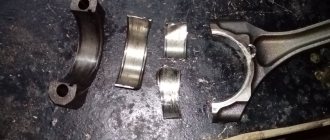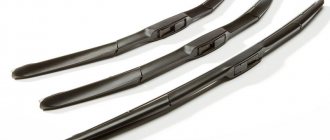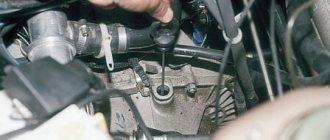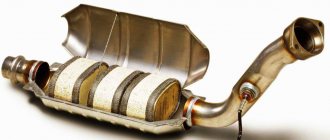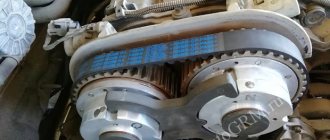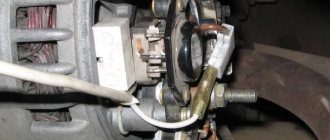Hello readers (-.-) I was bothered by an error on the second lambda (I checked it, the thread burned out) I thought about what to do with it. In general, the solution came quickly
Full sizeInsert 4-2-1 for two sensors (RUR 2,000). We screw the plug into the left one, and the first lambda into the right one. If the second one worked, then it would be possible to screw it in instead of the plug, because there is a snag there.
Full size It took about an hour and a half to unscrew the old one, for this I removed the inlet
Full size At the same time I bought a four-layer gasket (500 rubles), and the old one for trash. Next, the reverse assembly process
Full size assembly took less time than disassembly. I also changed the gasket between the exhaust and the resonator. And on the old release there are studs, which are not on the stinger, so you need to stock up on three bolts with washers for re-joining. Okay, we changed all that, but the error still remains. The next step is the chip. There are not many competent craftsmen in Simferopol, and I don’t really trust garage installation. In general, on to the next one. the day I went to chipovka on the recommendation of Lesha on Zalesskaya, he knows a lot not only about basins, but also about other things.
Full size Average consumption per 10 thousand mileage. In the morning, warm up for 15 minutes before going to work. Mileage highway/city 60/40. I usually drive along the highway 100-110.
Full size He removed the brains, danced with a tambourine and a kampuchter for about 15 minutes and did a test run. Later, check the inclusion of the fan, mass air flow sensor and everything. No errors were found. A pleasant picture of the tidy without Jackie Chan appeared)
Full sizeFirmware Motor Master Club. Let me remind you that my engine is 1.6 8 valve. Fan switching on is now 96 degrees, cut-off 7000 rpm. The idle speed is 40 rpm higher in order to avoid vibration and achieve stable idle operation. I paid 2500 for the firmware. First impressions are quite expected. The car started from the bottom without jerking or farting. Acceleration has become more pleasant and what is very pleasing is the disappearance of bluntness when switching from first to second, I think the Kalinovod drivers will understand me. Home 40 km, 10 in the city and 30 km on the highway. So, at a speed of 150 upon arrival home, the average consumption showed 6.3. It is clear that this is not an indicator. I’ll write more about the firmware after I’ve gone through at least a couple of thousand. And I saved the cherry for last. Having removed the brains, the master showed me a small puddle of antifreeze on them. Having examined the entire carpet, I did not notice anything. Apparently it just started leaking, because a couple of weeks ago I went to the brain to inspect for leaks. In short, I left my brains on the passenger mat, I’ll deal with them after the showdown with the stove. I’ve been wanting to move them from under the stove for a long time, but now I can’t put it off)
Full size droplets of antifreeze can be seen in the honeycombs of the mat(
Looking ahead, I’ll say that I changed the issue the day before yesterday (04/04/2019), flashed it yesterday (04/05), and today I worked on the stove. The car is already back in service, but I found an interesting way to change the radiator without removing the dashboard. If you're interested, I'll write about it tomorrow. Thank you for your attention !
Why do you need a catalyst?
I already have an article - what is it, I won’t repeat it. You need to understand that a catalyst (and scientifically, a catalytic converter) is needed only to clean the car's exhaust from harmful emissions and make them less harmful.
In simple words, it purifies harmful gases (while glowing almost “red hot”) and “almost” harmless CO2 and N2, O2 emerge from harmful CO, CH and other compounds. This way we save the environment at least a little.
Its structure is quite simple - it is a thickened pipe, which inside has something like a honeycomb, only long and hollow. They are usually made of ceramic elements coated with noble metals (usually platinum group metals are used - iridium, rhodium, palladium).
It is because of this that it costs, to put it mildly, quite a bit, from 30 to 150,000 rubles, it all depends on the class of the car and its volume.
In order for gases to transform from toxic to less harmful, the temperature of the catalyst must be about 750 degrees Celsius, otherwise the chemical reaction will not occur. The gases that come out of a car engine have a temperature of approximately 500 - 550 degrees Celsius (which is not enough), when they pass through the catalyst, a chemical reaction occurs with the release of heat, thus heating just the right amount (750 - 900 degrees).
The catalytic converter is knocked out, is this bad for the car?
As I wrote above, this is simply an environmental system, and if it is not there, then the car, on the contrary, will improve its characteristics (power, consumption). To put it simply, the engine doesn’t care about this converter, whether it is there or not.
But why on many cars, if this unit fails (say, melted, clogged or crumbled), the CHECK ENGINE starts to light up and the car begins to behave abnormally, traction disappears, sometimes it trots a little, and simply may not start at all.
And here, friends, everything is simple. If the catalyst is melted or clogged, then the exhaust gases cannot pass through it normally, which means that some returns back into the combustion chamber and makes the newly introduced combustible mixture less efficient. The motor is choking itself.
If there is no melting, but the “CHECK” light comes on, then perhaps it has simply worn out due to high mileage. In modern cars there are so-called oxygen sensors (lambda umbrellas), one is located in front of the catalyst, the other after and detects the presence of harmful compounds; if their percentage has increased, then the second (or also called the lower “lambda”) gives a signal that the converter is not working ( or it doesn’t do its job as it should) AND IT NEEDS TO BE REPLACED. By the way, some cars may not even start (a tribute to the environment).
Thus, by knocking out or removing it, you simply free the car’s exhaust tract from the obstacle in the form of a filter and lower its environmental standards. BUT AGAIN - THIS DOES NOT AFFECT THE RESOURCE OF THE POWER UNIT IN ANY WAY!
Firmware for EURO2 and snag – what does this mean?
As I wrote above, the second oxygen sensor (lower lambda) controls harmful emissions. Their number is now strictly regulated by European standards, which are called “EURO”; I will not talk about EURO “0-1” now; we are interested in the second generation.
So, what is EURO2? It was introduced a long time ago, namely in 1996. AT that time, the cars received an innovative system, namely a catalyst. As we all know, over time it can become clogged, and the fuel then was not the same as now, it had a lot of sulfur, which contributed to the honeycombs clogging much faster, and as you and I know, the car began to choke itself. Then the engineers installed an oxygen sensor, there was only one, and it was needed to capture CO2 in the chamber in front of the catalytic converter.
If the CO2 level increased, this indirectly indicated that the catalyst was clogged (that is, a backpressure effect was manifested); the sensor sent this information to the ECU and the ignition was adjusted, namely, a decrease in the supply of the fuel mixture. Thus, the power dropped significantly, the car did not drive and the owner “willy-nilly” had to go to a service station and change this spare part.
BUT, as you and I know, the price tag is, to put it mildly, HIGH, so many owners simply removed these honeycombs and the POWER RESTORED!
But how? YES, everything is simple, the CO2 level in the chamber in front of the neutralizer dropped significantly, the oxygen sensor recorded this (that everything is in order) and the car drove cheerfully and without constraint. This suited everyone, BUT NOT ECOLOGISTS! Therefore, they introduced the EURO3 standard (now the EURO5 standard already exists). What has changed is that a second oxygen sensor (lower lambda) just appeared behind the catalyst. The principle of operation here is this: the first lambda (before the filter) records the level of harmful substances, the second (after it) should record a much lower level, because the harmful substances have decomposed.
If you remove the catalyst cells, then both sensors will record the same values (“the second one” supplies information to the ECU), thus, CHECK ENGINE will light up, the power will drop, and the car will not drive. Now this doesn't solve the problem.
What is done with firmware for EURO2? The firmware in the ECU is changed, instead of EURO3.4 standards, EURO2 standards are installed. The essence of all these actions is banal - we simply turn off the second lower lambda (only the upper one remains), the car begins to drive as expected, without underestimating the power.
But such interventions in the firmware are not entirely good. The whole point is that they don’t produce them themselves, okay, the second “lambda” is simply turned off, that is, they simply adjust the readings. Or maybe this programmer will want to put some incomprehensible algorithms into the ECU, the engine will definitely not benefit from this. You need to be very careful here.
Therefore, we found a second solution, and I think it is more correct - installing a blende. What is a snag - essentially it is a “spacer” in front of the second oxygen sensor, it seems to move it a greater distance from the exhaust gases, it detects more oxygen and starts working normally.
Now there are several options for deception:
- Empty. It's just a tube with a very thin hole at the end (the part that screws into the muffler), and an oxygen sensor is screwed into the other side. A limited amount of harmful substances from the exhaust passes through it, there are no excesses and therefore CHECK does not burn.
- With a mini catalyst inside. That is, right in the “spacer” there are, as it were, mini honeycombs, which also clean the exhaust precisely to record normal values.
- Angular. These are both of the types described above, only they are made at an angle of 90 degrees; they are needed for difficult places.
The advantages of the decoy are that you don’t need to go into the ECU and change the standard firmware, as well as the price (knocked out the cells, screwed on the decoy and that’s it, you can spend 3,000 - 5,000 rubles).
How to determine the malfunction of the Lada-Kalina muffler
To find a faulty exhaust system, you don’t have to be a car mechanic or have extensive experience in car repairs. To identify problems, you need to act in the following sequence:
- Pay attention to noises that are made while driving. If the muffler is faulty, the sound will be quite loud. Extraneous noises also indicate problems with the exhaust system.
- Raise the car with a jack or drive onto an overpass and inspect the system body. A working device should have no holes or rust. The presence of traces of corrosion indicates that, most likely, there is a problem with the housing.
- While driving, you need to monitor the color of the exhaust: the periodic appearance of black and dense smoke will indicate that there are problems with the exhaust system.
- Start the engine and press the gas pedal for several minutes. Then turn off the ignition and check the engine temperature. During this time it should not get very hot. If it has risen significantly, it means that there are problems in the performance of the mechanism.
Pros and cons of deletion
I have prepared a small sign with the pros and cons of what will happen if you remove the catalyst
| MINUSES | PROS |
| Increase in harmful substances in the exhaust, decrease in the environmental component | There is no need to buy a new catalyst, because it is very expensive |
| The smell of the exhaust becomes much more toxic, sometimes this exhaust penetrates into the car (it smells unpleasant) | A small increase in power (really small in terms of error, about 3%) |
| Exhaust sound. After knocking out the catalyst honeycomb, it is advisable to install a flame arrester, otherwise there will be a ringing sound from the empty “can” (especially at high speeds) | You can install a 4-2-1 or 4-1 spider instead of an empty can, plus more power (which is said out of the blue) |
| You need to install either a fake or new firmware for EURO2 | Reduced fuel consumption (also about 3%) |
| Increasing the life of the power unit, because ceramic dust can get into the combustion chambers and wear it out prematurely |
As you can see, there are a few more advantages, the most significant is the price of this whole rework (removing it will cost several times, if not dozens of times, cheaper).
Now let's watch the video version.
In conclusion, I would like to say that removing the catalyst is NOT CORRECT AT ALL from an ECOLOGICAL point of view. After all, our planet is already polluted, and in this way you are making it even dirtier!
This is where I end, I think this material will help you make the right choice. Sincerely yours, AUTOBLOGGER.
Summary
According to some motorists, after tuning the car becomes faster, there is no hysterical roar when the revolutions approach 5,000. The exhaust sound has also changed, it has become more pleasant. In most cases, there is a decrease in fuel consumption. The financial component is also very noticeable - installing a 4-2-1 spider costs at least half as much.
LADA Kalina has been produced since 2003, when the first copies rolled off the assembly line. Before this, prototypes of future production models were repeatedly tested.
Tuning: replacing the catalyst on Kalina 8 valves with a 4-2-1 insert
When you need to replace the catalyst on a Kalina with an 8-valve engine, how to change it to a 4-2-1 spider insert and the main stages of the process.
In a car exhaust system, a catalytic converter is needed to burn harmful elements in the exhaust gases to the level of H2O and CO2. It is quite difficult to predict its service life, since it depends on many factors. But many owners of VAZ cars prefer to get rid of the collector before the end of its service life. For these purposes, they use special inserts, which are an inexpensive alternative to a neutralizer. Further more…
Join the group and you will be able to view images in full size
One of the questions that interests novice drivers is the functional features of such a part as a catalyst. Why is this element needed in the car, what problems can arise with it and how to solve them? A catalyst (catalytic converter) is one of the elements of a car’s exhaust system; it reduces the proportion of toxic substances in the exhaust.
The gas that comes out of the exhaust pipe contains hundreds of dangerous compounds, including CO2 - carbon dioxide, NO, NO2 - compounds of nitrogen with oxygen, CH - hydrocarbon, etc. They have a detrimental effect on human health, a great deal the concentration of these poisons in the air can lead to the emergence of dangerous diseases. The Lada Kalina catalyst contains noble metals. With their help, toxic elements break down into substances that are safe for humans.
The operating time of the catalyst is on average 100,000 kilometers, but its breakdown can occur even earlier. The reason for this may be malfunction of the starter, low-quality gasoline, or damage to the integrity of the part due to driving on an uneven road.
Fixing breakdowns
After the diagnostic procedure, and determining why the VAZ Kalina 8 valves are capricious, it is necessary to completely check the entire line of the unit, which is indicated by the decoding of the index. This must be done by testing the main line and replacing the blocks with known good ones. Additionally, the specifics of operation should be taken into account - due to constant shaking on broken roads, the standard terminals can become loose, which provokes a breakdown in contact. In this case, the computer will also indicate the presence of a malfunction. In order to prevent this, experienced craftsmen recommend treating connectors with special impregnations that repel water and carry out preventive maintenance in a timely manner.
Diagnosing Lada Kalina errors requires the necessary equipment and knowledge of how to decipher the indices generated by the program. In the absence of proper experience, information can be misinterpreted, which will lead to unnecessary procedures and waste of time. If necessary, you can contact a qualified specialist, but the services of service station masters are not cheap.
Source
When is it necessary to replace the catalyst on Kalina
If a malfunction is detected in the operation of a part, the computer displays the message “Check” on the information panel, which, when deciphered, shows the error “Ineffective operation of the catalyst.” This is fraught with a decrease in engine power (the car may not pick up speed above 60 km/h) and increased fuel consumption. If you ignore the problem, one day the car may simply not start.
Signs of the need to replace the catalyst on Kalina:
- the car exhaust has acquired a black color and a strong unpleasant odor;
- the car began to accelerate worse and lose speed when driving uphill;
- when the engine is running, grinding and knocking sounds are heard from the exhaust gas filter;
- The car began to consume more gasoline.
Environmental standards established in the Russian Federation do not regulate the level of permissible content of harmful gases in the exhaust. Due to this, owners of a Lada Kalina with a broken catalyst have three options:
- Replacing an old catalyst with a new one - many service stations offer this service, but it is quite expensive.
- Installation of alternative exhaust filters - a universal element that has a lower cost, or a flame arrester.
- Complete removal of the catalyst - this is equivalent to installing a so-called “spider”, which does not filter the exhaust, but removes smog directly from the engine. Because of this, the level of toxic substances in the atmosphere increases.
Technical features of the insert
Installing catalyst replacements can eliminate the problem of a clogged exhaust filter and return the car to its previous performance - power and gas mileage. But what are these substitutes? This insert is a hollow pipe that does not have filters. It is made in the form of a catalyst and in most cases there are no problems with its installation. After installing the insert instead of the factory exhaust gas filter, drivers observe:
- acceleration of warming up of the car in the cold season;
- the car picks up speed better;
- fuel consumption is reduced.
In some cases, there is a change in the sound volume when the car is running. The sound becomes more bassy. The Lada Kalina computer can display “Check” on the dashboard when driving with the insert. To prevent this, use a lambda probe or oxygen sensor. This sensor is an integral part of the exhaust system with a catalyst. The sensor analyzes the level of oxygen and harmful gases in the exhaust and transmits the information to the on-board computer. Based on the data obtained, the computer determines the performance of the catalyst. The lambda probe cannot be repaired; if it breaks, the part must be replaced.
Since the insert does not reduce the level of toxic substances in the exhaust, the lambda probe will constantly transmit information about a catalyst malfunction. To avoid this, special devices are used - decoys. They come in two types: mechanical and electronic.
Mechanical blende is a bronze spacer of a certain size, filled with ceramic chips coated with a catalytic layer. Exhaust gases pass through the small holes of the device, interacting with the crumbs, due to which the CO2 concentration is reduced. Electronics analyzes the changes and sends information to the computer about the normal operation of the catalyst.
Electronic snag is a high-tech device based on a single processor. Such a device analyzes the operation of the exhaust gas purification system and transmits information about the serviceability of the catalyst. The electronics understand that smog filtering is not happening, but generates a signal corresponding to the correct functioning of the system.
Installing electronic deception involves reflashing the computer to exclude from its code the calculations of dosage corrections transmitted by the rear oxygen sensor. The program does not save records of catalyst operation errors in the computer memory.
You can replace the catalyst with an insert in many car repair shops. Self-replacement is recommended only if you have the appropriate tools, skills and experience. You can install electronic deception yourself, but you need to have a good understanding of the principles of computer operation and have the necessary software. Otherwise, the car owner risks making the situation worse.
Replacing the catalyst with a “spider”
Lada Kalina cars of both the first and second generation are equipped at the factory with a collector-type catalytic converter-neutralizer. It is made in the same housing with the receiving manifold. Depending on the environmental class of the car (“Euro-2” or “Euro-3”) it has one or two oxygen sensors. When the catalyst fails, there is a need to replace it.
If the message “Check” appears on the information panel, the first thing you need to do is conduct computer diagnostics of the electronic control unit. With its help, you can determine whether the problem is really a malfunction of the car's filtration system or whether there is another breakdown. When the program confirms a malfunction of the catalyst, it is necessary to replace it - the part cannot be repaired. Most often, car enthusiasts prefer the option that involves installing a “spider” instead of a broken catalyst.
Basic design of the self-diagnosis system
The automatic fault diagnosis system on the Lada consists of several devices. It is the information received from them that we later see as fault codes. Typically, the manufacturer does not recommend self-service to car owners and therefore the location of some of them is not disclosed.
This is done so that dishonest people cannot, for example, “twist” mileage figures or somehow change engine characteristics before selling the car. For the same reason, it is recommended that servicing of the self-diagnosis system be carried out only at official service stations that have the appropriate permission from the vehicle manufacturer.
In addition, another element of the automatic diagnostic system is the on-board computer. It is he who processes the information collected by the sensors, which we then read as Lada Kalina error codes. At the same time, there are different versions of such systems that allow, for example, to visually represent the location of detection of a particular defect.
Unfortunately, Kalina does not have such a computer, and its owner can only see a digital designation of a particular malfunction. That is why every car owner needs to remember the errors of the Kalina on-board computer by heart in order to take timely measures to eliminate this or that malfunction.
Sequence of work in the 8-valve Kalina
The first step is to fill all threaded connections with liquid wrench. When exposed to high temperatures for a long time, nuts become deformed and destroyed due to corrosion, so unscrewing them is quite problematic. After tightening the nuts, the following work is carried out:
- the coolant is drained;
- lambda probe chips are removed;
- unscrew the bolts that secure the intake manifold to the cylinder head and exhaust pipe;
- the holding bracket is dismantled;
- the exhaust manifold is removed;
- the lambda probe wire is extended;
- “spider” is installed;
- the system is assembled in reverse order.
There are different spider options: 4-1 system; 4-2-1; 4-2-1 with modified sound. The most popular is 4-1. The design has four pipes converging into one, which are welded to the cylinder head plate. The 4-2-1 system is also made of four pipes, the first and second of which converge into one, as well as the third and fourth. The two pipes then form one and transmit the exhaust gases further into the system.
When installing the 4-2-1 spider, the exhaust pipe is shortened. As a result, it will be impossible to install a 4-1 design blende or a new catalyst into the car without modification. The 4-1 system is completely identical to the Kalina factory catalyst.
Installing a spider in a 16-valve car
The sixteen-valve Kalina is equipped with a complex power supply and gas distribution system, so the work carried out will be more labor-intensive. The sequence of actions is as follows:
- removing the terminals from the battery, draining the coolant;
- loosening the clamps securing the air duct pipe and the throttle assembly to the filter;
- the pipe is removed;
- the chip is disconnected from the throttle assembly and oxygen sensor;
- the hose of the crankcase ventilation system is removed;
- the adsorber purge hose is disconnected;
- the receiver mounting bracket is unscrewed;
- the nuts are unscrewed and the receiver is removed;
- unscrew the upper and lower fastening nuts, remove the heat-insulating shield and eye;
- the fastenings of the spacer to the exhaust manifold are twisted;
- the heat shield is removed;
- the intake manifold is dismantled, for which you need to unscrew nine nuts near the block head and three at the exhaust pipe;
- “spider” is mounted;
- the lambda probe wire is extended, a mechanical or electronic snag is installed;
- The elements are assembled in the reverse order.
Replacing a catalyst is a rather complicated process. Inattention during operation can lead to damage to the vehicle's exhaust system and engine wear. Repairs should only be started if you have all the tools and replacement parts.
The catalyst prevents atmospheric pollution with carbon monoxide and other toxic substances. Its service life is not designed for more than 100,000 kilometers of vehicle mileage, so every owner will sooner or later be faced with the need to replace this element. You can replace the catalyst yourself or by contacting a service station. It is important to remember that inept DIY repairs will worsen the problem and cause additional costs in the future.
Catalytic converter for Lada Priora
For proper operation of the system, oxygen sensors (lambda probes) are installed in front of the catalytic unit and immediately behind it. The sensor located before the neutralizer is called control, and the one installed after is called diagnostic.
In world practice, a different arrangement of the catalytic converter is used. This scheme with the location of the barrel of the catalytic converter under the bottom of the car appeared at the dawn of the use of this method of reducing exhaust gas toxicity and is still used, for example, on Renault cars with Euro-4 and even Euro-5 standards.

